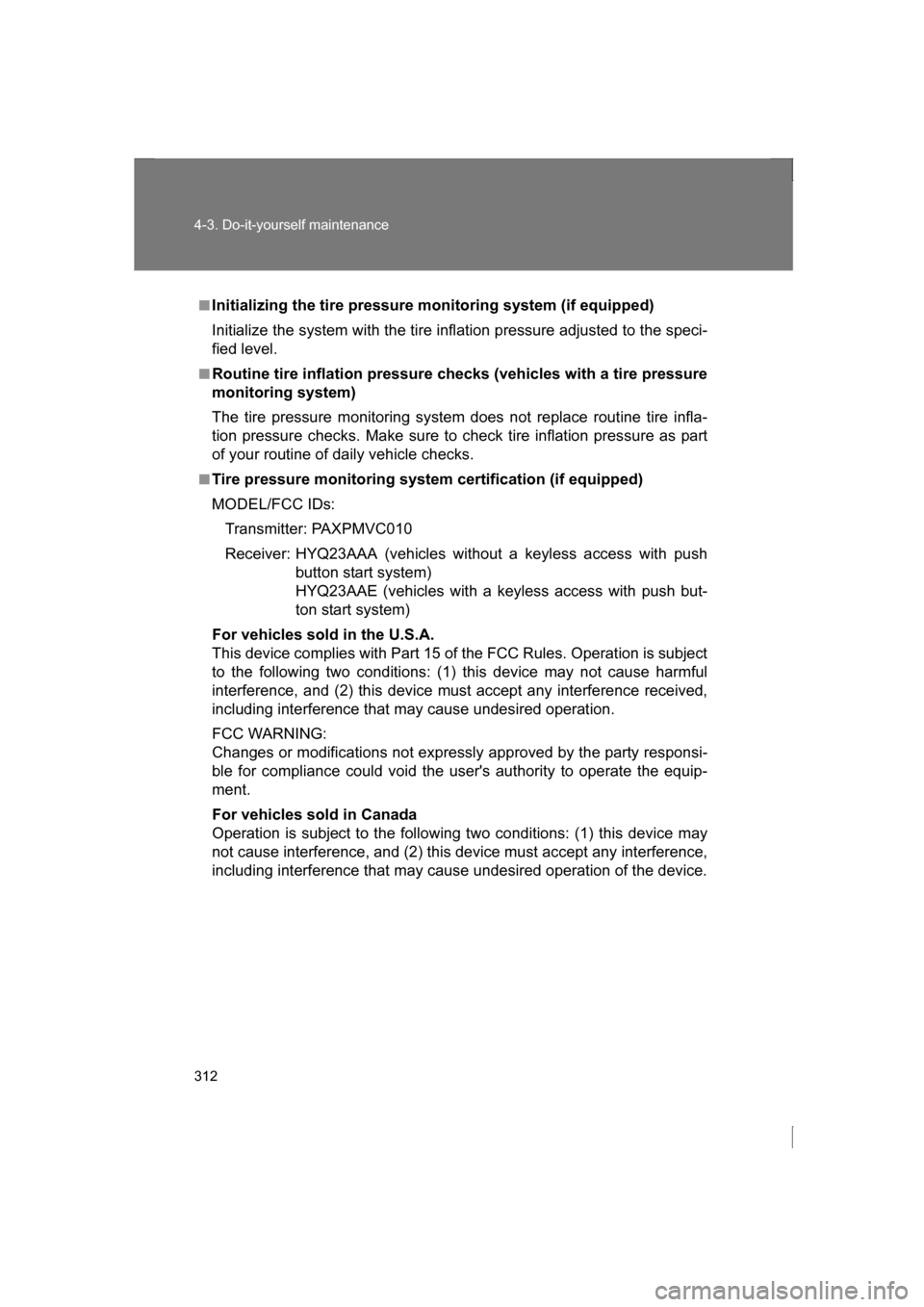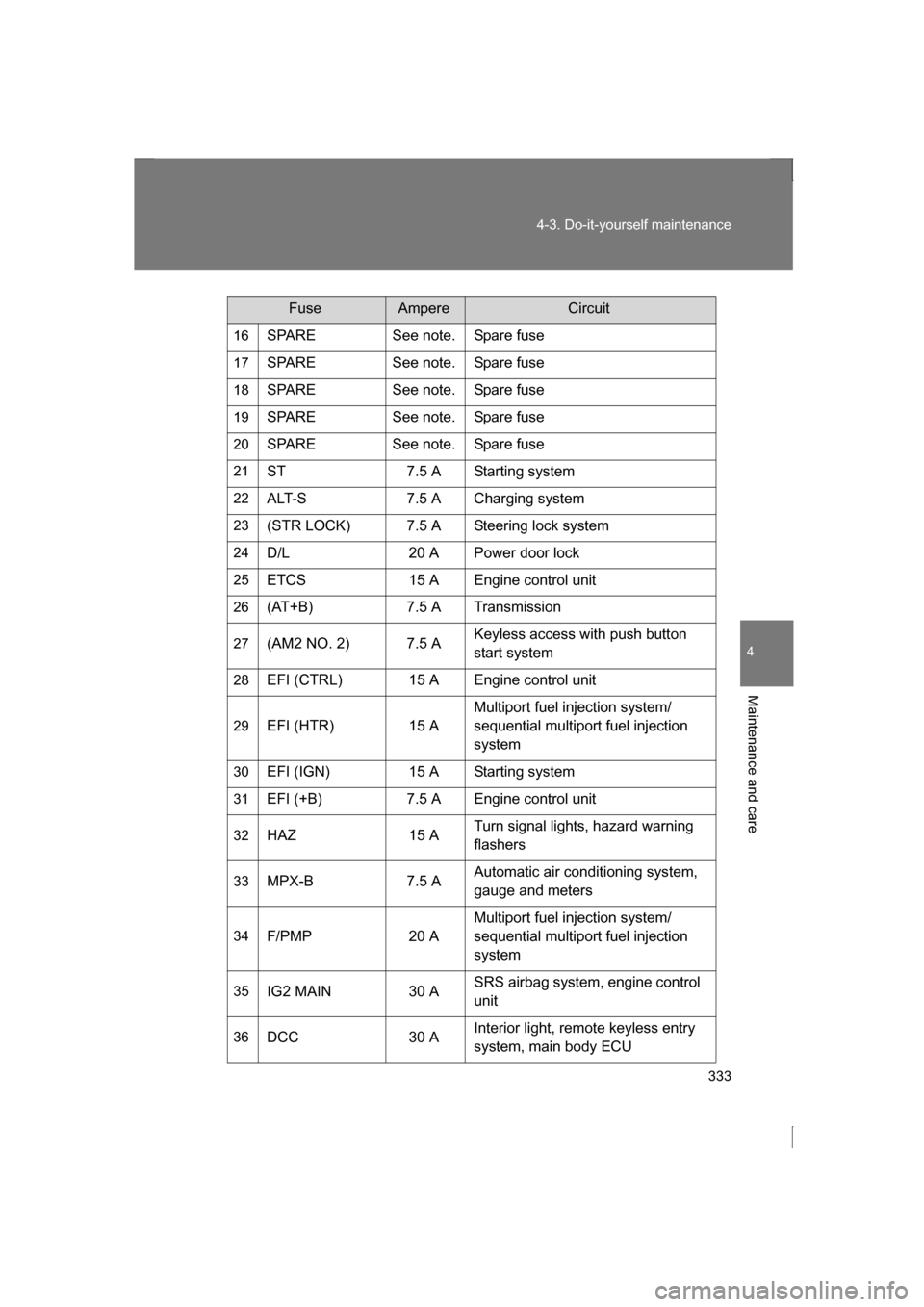Page 304 of 484

304
4-3. Do-it-yourself maintenance
■Before recharging
When recharging, the battery produces hydrogen gas which is flammable
and explosive. Therefore, before recharging:
●If recharging with the battery installed on the vehicle, be sure to discon-
nect the ground cable.
●Make sure the power switch on the charger is off when connecting and
disconnecting the charger cables to the battery.
■After recharging/reconnecting the battery (vehicles with a keyless
access with push button start system)
●Unlocking the doors using the keyless access with push button start sys-
tem may not be possible immediately after reconnecting the battery. If
this happens, use the remote keyless entry system or the mechanical
key to lock/unlock the doors.
●Start the engine with the push-button ignition switch in “ACC” mode. The
engine may not start with the push-button ignition switch turned off. How-
ever, the engine will operate normally from the second attempt.
●The push-button ignition switch mode is recorded by the vehicle. If the
battery is reconnected, the vehicle will return the push-button ignition
switch mode to the status it was in before the battery was disconnected.
Make sure to turn off the engine before disconnect the battery. Take extra
care when connecting the battery if the push-button ignition switch mode
prior to discharge is unknown.
If the engine will not start even after multiple attempts, contact your
SUBARU dealer.
Page 312 of 484

312
4-3. Do-it-yourself maintenance
■Initializing the tire pressure monitoring system (if equipped)
Initialize the system with the tire inflation pressure adjusted to the speci-
fied level.
■Routine tire inflation pressure checks (vehicles with a tire pressure
monitoring system)
The tire pressure monitoring system does not replace routine tire infla-
tion pressure checks. Make sure to check tire inflation pressure as part
of your routine of daily vehicle checks.
■Tire pressure monitoring system certification (if equipped)
MODEL/FCC IDs:Transmitter: PAXPMVC010
Receiver: HYQ23AAA (vehicles without a keyless access with push button start system)
HYQ23AAE (vehicles with a keyless access with push but-
ton start system)
For vehicles sold in the U.S.A.
This device complies with Part 15 of the FCC Rules. Operation is subject
to the following two conditions: (1) this device may not cause harmful
interference, and (2) this device must accept any interference received,
including interference that may cause undesired operation.
FCC WARNING:
Changes or modifications not expressly approved by the party responsi-
ble for compliance could void the user's authority to operate the equip-
ment.
For vehicles sold in Canada
Operation is subject to the following two conditions: (1) this device may
not cause interference, and (2) this device must accept any interference,
including interference that may cause undesired operation of the device.
Page 322 of 484
322
4-3. Do-it-yourself maintenance
Air conditioning filter
The air conditioning filter must be changed regularly to maintain air
conditioning efficiency.
■Removal methodVehicles without a keyless access with push button
start system
Turn the engine switch off.
Vehicles with a keyless access with push button start
system
Turn the push-button ignition switch off. Open the glove box. Slide off
the damper.
Push in each side of the glove
box to disconnect the claws.
STEP 1
STEP 2
STEP 3
Page 325 of 484
325
4-3. Do-it-yourself maintenance
4
Maintenance and care
Transmitter/access key batter y
Replace the battery with a new one if it is depleted.
■You will need the following items: ●Flathead screwdriver
● Lithium battery CR2016 (vehicles without a keyless access
with push button start system), or CR1632 (vehicles with a
keyless access with push button start system)
■Replacing the battery (vehicles without a keyless access
with push button start system)
Remove the cover.
To prevent damage to the key,
cover the tip of the screwdriver
with a rag.
To prevent the buttons from
being disassembled, face the
button surface downward.
Remove the module.
STEP1
STEP2
Page 326 of 484
326
4-3. Do-it-yourself maintenance
Open the case cover using a
coin protected with tape and
remove the depleted battery.Insert a new battery with the
“+” terminal facing up.
■Replacing the battery (vehicles with a keyless access with
push button start system) Take out the mechanical key.
Remove the cover.
To prevent damage to the key,
cover the tip of the screwdriver
with a rag.
STEP3
STEP1
STEP2
Page 327 of 484

327
4-3. Do-it-yourself maintenance
4
Maintenance and care
■Use a CR2016 (vehicles without a keyless access with push button
start system) or CR1632 (vehicles with a keyless access with push but-
ton start system) lithium battery
●Batteries can be purchased at your SUBARU dealer, local electrical
appliance shops or camera stores.
●Replace only with the same or equivalent type recommended by the
manufacturer.
●Dispose of used batteries according to local laws.
■If the key battery is depleted
The following symptoms may occur:
●The keyless access with push button start system (if equipped) and
remote keyless entry system will not function properly.
●The operational range will be reduced.
■When putting the module back (vehicles without a keyless access with
push button start system) Remove the depleted battery.
Insert a new battery with the
“+” terminal facing up.
STEP3
Insert the module from directly above.
Inserting it on an angle may prevent the
key buttons from operating properly.
Page 329 of 484
329
4-3. Do-it-yourself maintenance
4
Maintenance and care
Checking and replacing fuses
If any of the electrical components do not operate, a fuse may have
blown. If this happens, check and replace the fuses as necessary.Vehicles without a keyless access with push button
start system
Turn the engine switch off.
Vehicles with a keyless access with push button start
system
Turn the push-button ignition switch off.
Open the fuse box cover.
Engine compartment Push the tabs in and lift the lid
off.
Instrument panel Remove the lid.
STEP 1
STEP 2
Page 333 of 484

333
4-3. Do-it-yourself maintenance
4
Maintenance and care
16SPARE See note. Spare fuse
17 SPARE See note. Spare fuse
18 SPARE See note. Spare fuse
19 SPARE See note. Spare fuse
20 SPARE See note. Spare fuse
21 ST 7.5 A Starting system
22 ALT-S 7.5 A Charging system
23 (STR LOCK) 7.5 A Steering lock system
24 D/L 20 A Power door lock
25 ETCS 15 A Engine control unit
26 (AT+B) 7.5 A Transmission
27 (AM2 NO. 2) 7.5 A Keyless access with push button
start system
28 EFI (CTRL) 15 A Engine control unit
29 EFI (HTR) 15 A Multiport fuel injection system/
sequential multiport fuel injection
system
30 EFI (IGN) 15 A Starting system
31 EFI (+B) 7.5 A Engine control unit
32 HAZ 15 A Turn signal lights, hazard warning
flashers
33 MPX-B 7.5 A Automatic air condi
tioning system,
gauge and meters
34 F/PMP 20 A Multiport fuel injection system/
sequential multiport fuel injection
system
35 IG2 MAIN 30 A SRS airbag system, engine control unit
36 DCC 30 A Interior light, remote keyless entry
system, main body ECU
FuseAmpereCircuit